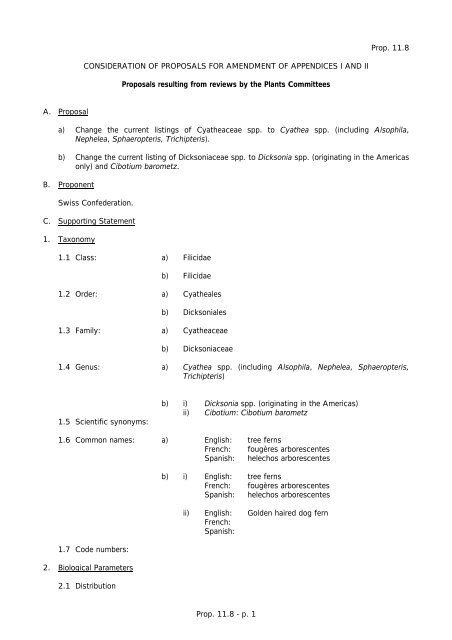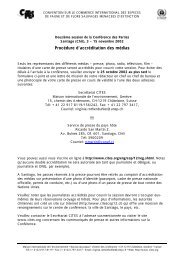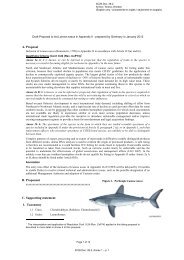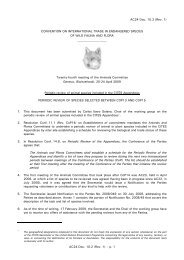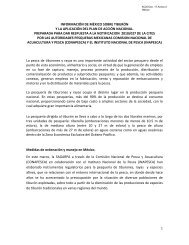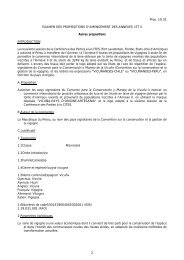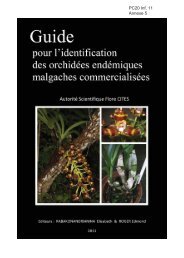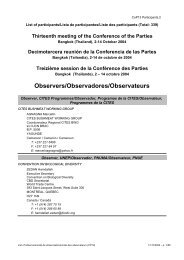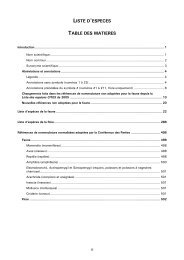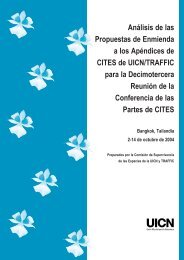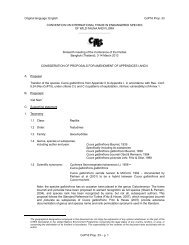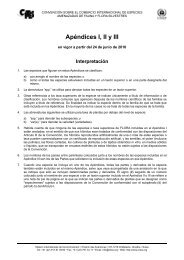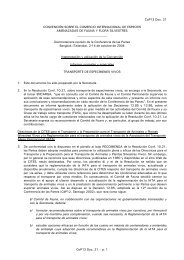Prop. 11.8 - Cites
Prop. 11.8 - Cites
Prop. 11.8 - Cites
Create successful ePaper yourself
Turn your PDF publications into a flip-book with our unique Google optimized e-Paper software.
<strong>Prop</strong>. <strong>11.8</strong><br />
CONSIDERATION OF PROPOSALS FOR AMENDMENT OF APPENDICES I AND II<br />
<strong>Prop</strong>osals resulting from reviews by the Plants Committees<br />
A. <strong>Prop</strong>osal<br />
a) Change the current listings of Cyatheaceae spp. to Cyathea spp. (including Alsophila,<br />
Nephelea, Sphaeropteris, Trichipteris).<br />
b) Change the current listing of Dicksoniaceae spp. to Dicksonia spp. (originating in the Americas<br />
only) and Cibotium barometz.<br />
B. <strong>Prop</strong>onent<br />
Swiss Confederation.<br />
C. Supporting Statement<br />
1. Taxonomy<br />
1.1 Class: a) Filicidae<br />
b) Filicidae<br />
1.2 Order: a) Cyatheales<br />
b) Dicksoniales<br />
1.3 Family: a) Cyatheaceae<br />
b) Dicksoniaceae<br />
1.4 Genus: a) Cyathea spp. (including Alsophila, Nephelea, Sphaeropteris,<br />
Trichipteris)<br />
1.5 Scientific synonyms:<br />
b) i) Dicksonia spp. (originating in the Americas)<br />
ii) Cibotium: Cibotium barometz<br />
1.6 Common names: a) English: tree ferns<br />
French: fougères arborescentes<br />
Spanish: helechos arborescentes<br />
1.7 Code numbers:<br />
2. Biological Parameters<br />
2.1 Distribution<br />
b) i) English: tree ferns<br />
French: fougères arborescentes<br />
Spanish: helechos arborescentes<br />
ii) English: Golden haired dog fern<br />
French:<br />
Spanish:<br />
<strong>Prop</strong>. <strong>11.8</strong> - p. 1
Representatives of the Cyatheaceae and Dicksoniaceae can be found in all tropical regions of<br />
the world. Some smaller genera have a more restricted, continental distribution.<br />
Family Genus Comments Commercial<br />
Trade<br />
Cyatheaceae Alsophila Included in Cyathea as subgenus ---<br />
Cyatheaceae Cnemidaria Tropical America; ca. 23 species No<br />
Cyatheaceae Cyathea Pantropical, 600 species Yes<br />
Cyatheaceae Nephelea Included in Cyathea as subgenus ---<br />
Cyatheaceae Sphaeropteris Included in Cyathea as subgenus ---<br />
Cyatheaceae Trichipteris Included in Cyathea as subgenus ---<br />
Dicksoniaceae* Calochlaena Tropical Asia, Oceania, segregated from<br />
Culcita senso stricto<br />
Dicksoniaceae Cibotium Pantropical 12 species, only C. barometz<br />
reported to be in trade<br />
Dicksoniaceae* Culcita Tropical America, 1 species No<br />
Dicksoniaceae Cystodium Tropical Asia, Oceania, 1 species No<br />
Dicksoniaceae Dicksonia Tropical America, Oceania, South East Asia<br />
(high elevations); D. sellowiana: widespread<br />
from Mexico to South Brazil, height 10m.<br />
Easy to recognize because of the presence<br />
golden hairs and the absence of spines or<br />
scales<br />
Dicksoniaceae** Thyrsopteris Endemic; Juan Fernandez Island; 1 species No<br />
Lophosoriaceae Lophosoria 1 species, tropical South America No<br />
Metaxyaceae Metaxya 1 species, tropical South America No<br />
* Also treated in a separate family; Culcitaceae (see, e.g., Pichi Sermolli 1977).<br />
**Also treated in a separate family; Thyrsopteridaceae (see, e.g., Pichi Sermolli 1977).<br />
2.2 Habitat availability<br />
2.3 Population status<br />
The trade data – quality of which was sometimes poor and inconsistent – demonstrated that<br />
about 60 species of Cyatheaceae and Dicksoniaceae have appeared in international trade.<br />
Most of the species are traded in very small quantities, almost all for scientific purposes. Ten<br />
species are traded in significant quantities: Cyathea arborea, Cyathea biformis, Cyathea<br />
latebrosa, Cyathea lepifera, Calochlaena dubia, Dicksonia antartica, Dicksonia fibrosa,<br />
Dicksonia sellowiana, Dicksonia squarrosa. These are common, non-threatened species. Only<br />
Dicksonia sellowiana and Cyathea biformis are considered as ‘Endangered’ in its major<br />
country of export: Brazil. In Australia and New Zealand, commercial trade of tree fern is well<br />
regulated. They are export countries for four of the commercially traded species (Calochlaena<br />
dubia, Dicksonia antartica, Dicksonia fibrosa and Dicksonia squarrosa). D. Given reported that<br />
there are no threatened species in New Zealand and that there would be no benefit for them<br />
to be listed by CITES. Trade is mostly national or local, there is little export.<br />
2.4 Population trends<br />
Species may be threatened locally, mainly because of habitat destruction.<br />
2.5 Geographic trends<br />
Yes<br />
Yes<br />
Yes<br />
<strong>Prop</strong>. <strong>11.8</strong> - p. 2
Not applicable.<br />
2.6 Role of the species in its ecosystem<br />
Not applicable.<br />
2.7 Threats<br />
Not applicable.<br />
3. Utilization and Trade<br />
3.1 National utilization<br />
Stems of species of Cyathea and Dicksonia are used as substrate for orchid propagation.<br />
Cibotium barometz is used for its medicinal properties.<br />
3.2 Legal international trade<br />
Taxa are traded either as:<br />
• live plants (all taxa);<br />
• leaves (Cyathea alata, C. albifrons, C. intermedia, C. novae-caledoniae, C. veillardii,<br />
Calochlaena dubia);<br />
• stems (Cyathea contaminans, Calochlaena dubia, Dicksonia fibrosa, D. squarrosa);<br />
• fibres (Cyathea arborea, Cyathea spp., Dicksonia squarrosa);<br />
• flowerpots (Dicksonia fibrosa, D. sellowiana);<br />
• roots and rhizoms (Cibotium barometz).<br />
Import / Export of Tree Ferns 1996-1997 (data from WCMC)<br />
Family Taxon Exporter Importer Quantity<br />
CYAT Alsophila firma CR US 2<br />
CYAT<br />
Alsophila<br />
polystichoides<br />
CR US 2<br />
CYAT Alsophila spp. CR, ES US, MA 9<br />
CYAT Cnemidaria choricarpa CR US 2<br />
CYAT Cyathea abbottii DO US 4<br />
CYAT Cyathea alata NC US 2 / 1 ship, leaves<br />
CYAT Cyathea albifrons NC US 1 ship, leaves<br />
CYAT Cyathea arborea GT US 139 m2, fibres<br />
CYAT Cyathea bicrenata CR US 2<br />
CYAT Cyathea borbonica MG FR 1<br />
CYAT Cyathea brownii AU, NZ GB 123<br />
CYAT Cyathea contaminans ID JP, TW 50, 17940 stems<br />
CYAT Cyathea cooperi AU, NZ, ZA GB 129<br />
CYAT Cyathea crassa DO US 2<br />
CYAT Cyathea cunninghamii GB AU 50<br />
CYAT Cyathea dealbata AU, NZ GB, CA, FR, NL 400+<br />
CYAT Cyathea delgadii CR US 2<br />
CYAT Cyathea dregei HK, ZA US, GB 66<br />
CYAT Cyathea fulgens DO US 4<br />
<strong>Prop</strong>. <strong>11.8</strong> - p. 3
Family Taxon Exporter Importer Quantity<br />
CYAT Cyathea fulva CR US 2<br />
CYAT Cyathea imrayana CR US 2<br />
CYAT Cyathea incisoserrata ZA GB 12<br />
CYAT Cyathea insignis DO US 2<br />
CYAT Cyathea intermedia NC US 1 ship, leaves<br />
CYAT Cyathea lepifera ZA GB 12<br />
CYAT Cyathea medullaris AU, NZ GB, NL, FR, CA 500+<br />
CYAT Cyathea microdonta CR US 2<br />
CYAT Cyathea milnei ZA GB 6<br />
CYAT Cyathea minor DO US 4<br />
CYAT<br />
Cyathea novaecaledoniae<br />
NC US 2, 1 ship, leaves<br />
CYAT Cyathea parvula DO US 2<br />
CYAT Cyathea pinnula CR US 2<br />
CYAT Cyathea robertsiana AU GB 1<br />
CYAT Cyathea robusta AU GB 50<br />
CYAT Cyathea schiediana CR US 2<br />
CYAT Cyathea smithii NZ GB, CA, FR 300+<br />
CYAT Cyathea stelligera NC US 3<br />
CYAT Cyathea suprastrigosa CR US 2<br />
CYAT<br />
Cyathea<br />
tomentosissima<br />
AU, ZA GB 64<br />
CYAT Cyathea urbanii DO US 2<br />
CYAT Cyathea vieillardii NC US 2, 1 ship, leaves<br />
CYAT<br />
Cyathea<br />
woodwardiodes<br />
DO US 2<br />
CYAT Cyathea woollsiana AU GB 15<br />
CYAT Cyathea spp. CR, GT, ID, MG,<br />
ST, AU, CU, FJ,<br />
PY<br />
US, FR, PT, GB,<br />
GH, CH, MU, AT<br />
160+, fibres<br />
(300+m3), dried pl.<br />
(48)<br />
DICK Calochlaena dubia AU JP, US 50000 leaves, 45000<br />
stems<br />
DICK Cibotium barometz CN, HK, VN, CL de, ca, hk, kr, us 100’000+ roots, 25kg<br />
live<br />
DICK Cibotium spp. CL, DE, VN DE, CL, US 1, 200gr. derivatives<br />
DICK Dicksonia antarctica AU, (CA), (FR) NL, AE, AU, FR,<br />
GB, IT, JP, NL,<br />
US, CH<br />
DICK Dicksonia fibrosa NZ GB, JP, NL, CA,<br />
FR<br />
DICK Dicksonia gigantea CR US 2<br />
125’000+<br />
150+, 205+ stems,<br />
590 flowerpots<br />
DICK Dicksonia sellowiana BR, (ZA) DE, GB 6, 14’400+ flowerpots<br />
DICK Dicksonia squarrosa NZ GB, JP, CA, FR,<br />
NL<br />
DICK<br />
Dicksonia<br />
thyrsopteroides<br />
NC US 1 ship live<br />
DICK Dicksonia youngiae ZA GB 6<br />
DICK Dicksonia spp. NZ, CA, AU, PY GB, US, AT 120+<br />
220+, fibres+,<br />
flowerpots+, stems+<br />
<strong>Prop</strong>. <strong>11.8</strong> - p. 4
(from WCMC, Dec. 98)<br />
in ( ) = re-exports<br />
3.3 Illegal trade<br />
Some shipments have been confiscated in the past. There is no information on recent illegal<br />
trade.<br />
3.4 Actual or potential trade impacts<br />
Those taxa for which it is believed that trade might have a negative impact on the populations<br />
are maintained in Appendix II.<br />
3.5 Captive breeding or artificial propagation for commercial purposes (outside country of origin)<br />
Tree ferns of the genera Cyathea and Dicksonia are relatively easy to propagate although this<br />
is currently not happening on a very large scale. Cibotium barometz is currently not in<br />
cultivation on a commercial scale.<br />
4. Conservation and Management<br />
4.1 Legal status<br />
4.1.1 National<br />
Through national legislation, protection is provided in many range States. However,<br />
the level of this protection may vary between the range States.<br />
4.1.2 International<br />
Cyathea capensis, C. dredgei, C. mexicana and C. calwinii have been included in<br />
Appendix II since 1 July 1975. At the first meeting of the Conference of the Parties<br />
this listing was amended to Cyatheaceae spp. and at the same time the family<br />
Dicksoniaceae was also included in Appendix II.<br />
4.2 Species management<br />
4.2.1 Population monitoring<br />
Not applicable.<br />
4.2.2 Habitat conservation<br />
Not applicable.<br />
4.2.3 Management measures<br />
4.3 Control measures<br />
Harvesting of tree ferns, as part of the forest management, is apparently well<br />
regulated in Australia and New Zealand.<br />
4.3.1 International trade<br />
Not applicable.<br />
4.3.2 Domestic measures<br />
Not applicable.<br />
<strong>Prop</strong>. <strong>11.8</strong> - p. 5
5. Information on Similar Species<br />
None.<br />
6. Other Comments<br />
All range States have been informed about the recommendation of the Plants Committee (see<br />
below).<br />
The following Parties expressed support for the proposal: Argentina, Australia, Belize, Bermuda,<br />
Brazil, Chile, China, Namibia, New Zealand, Peru, Philippines, St. Helena (United Kingdom),<br />
Seychelles, Singapore, Suriname, United States of America.<br />
Bangladesh indicated in its response that few species occur in its territory, in two densities. It<br />
would thus support recommendations in favour of strict regulation or prohibition of trade in tree<br />
ferns from nature.<br />
7. Additional Remarks<br />
At its fifth meeting (San Miguel de Allende, Mexico, 1994), the Plants Committee discussed a<br />
document prepared by WCMC, containing information on trade and conservation status. It was<br />
decided that a more detailed review should be carried out. At its sixth meeting (Tenerife, Spain,<br />
1995) the Plants Committee discussed the document International trade in tree fern – an<br />
evaluation of CITES prepared by WCMC under contract with the Secretariat. At its seventh<br />
meeting (San Juan, Costa Rica, 1996) and eight meeting (Pucón Chile, 1997), the Plants<br />
Committee discusses this subject in further detail, also in relation to possible identification<br />
problems. At its ninth meeting (Darwin, Australia, 1999) the Plants Committee, as part of its<br />
programme on the review of the Appendices, recommended that the current listing of tree ferns be<br />
amended as proposed in this document.<br />
8. References<br />
Buchner R., Dietrich G., Kiehn M., 1997: Tree fern parts in trade in Central and South America. -<br />
CITES News - Plants, March 1997: 3.<br />
Pichi Sermolli, R.E.G., 1977: Testamen Pteridophytorum genera in taxonomicum ordinem<br />
redigendi. - Webbia 31, 313-512.<br />
Proctor, G.R., 1977: Pteridophyta. In Howard, R.A. (ed.): Flora of the Lesser Antilles 2: 103. -<br />
Arnold Arboretum, Cambridge, Mass. (USA).<br />
Tryon R.M., Tryon A.F. (1982) Ferns and allied plants. Springer, New York, Heidelberg, Berlin.<br />
World Conservation Monitoring Centre (1995) International trade in tree ferns - an evaluation of<br />
the application of CITES and literature cited therein.<br />
<strong>Prop</strong>. <strong>11.8</strong> - p. 6


